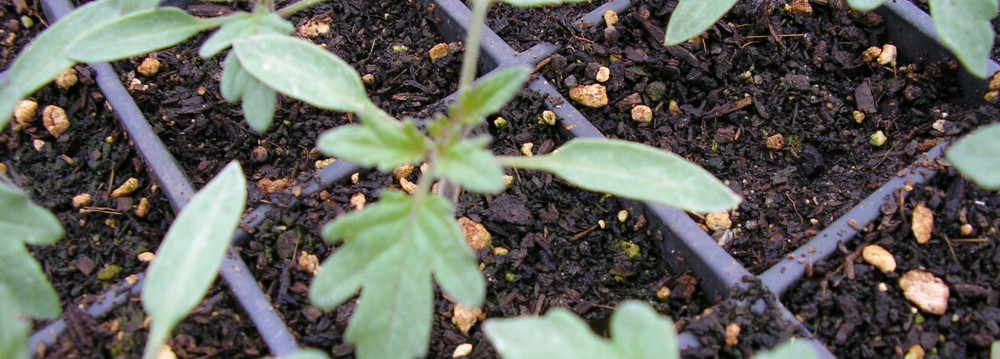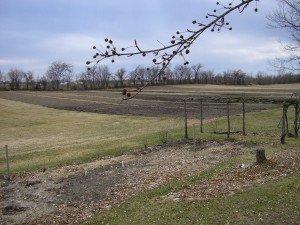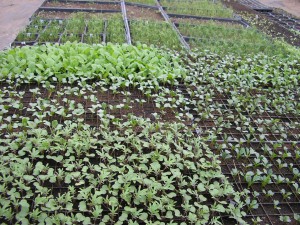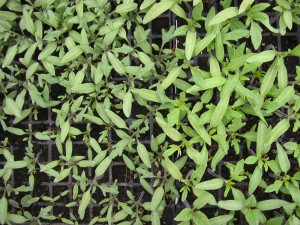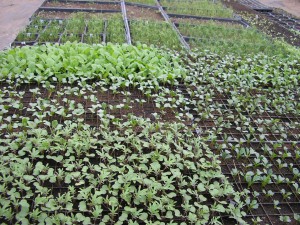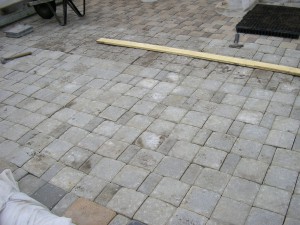Riverbend Farm Early Summer Newsletter
CSA started this week so I suppose I should get busy and write a newsletter.
First of course is the mosquito report. We have had 3.36” of rain in the past two weeks. The warm weather last week brought out all the mosquitoes that had been hanging back since the first of May. They are thick. The good news is that they have sucked all the juice out of the wood ticks and slowed them down.
As is usual for these days, it has been a bit of an up and down sort of season. Early on it was very warm. May was cool and we had some flat out hot humid weather in early June. The cool weather kept things from growing and the hot weather made them bolt to seed. I have lots of arugula and radish flowers. Rapini had about 3 leaves when it flowered.
Cutting back on the bunched greens and radishes looks like a good move at this point. We have a much smaller crew this year. Right now our crew consists of Nikki and Gwen, who work Mondays and Thursdays. Margaret was a great help with all the transplants, but the commute was killing her. Not spending 3-4 days per week bunching and delivering opened up a lot of time to keep up on primary tillage, planting and cultivating. Cultivation is a little behind right now due to the regular rain. Our on-farm pick up only CSA is also much smaller but we did a ton of veggie transplant business this spring (since Gardens of Eagan closed). That has helped a lot with cash flow. And we learned a lot about growing thousands of starter plants. Next year…
All in all, it has been a typically busy spring but we have had an absolute whirlwind of activity here in the past few weeks. Since Memorial Day we have had a crop mob, visitors and have been plowing, planting, planting, cultivating, plowing, and more planting.
Usually crop mobs are the last Saturday of the month, but we had about 2½” of rain the last week of May. It was too wet to do any field work to get ready to plant. A couple dry days and Monday was just about perfect, also, being Memorial day, there was a chance that some of the people who signed up for Saturday could still make it.
Monday is a regular work day for us, so Nikki and Gwen were here early to get things ready. It was nice to have help organizing the crop mob. The crop mobs consist of a mix of people who show up for almost every one and new people who sometimes come back for a second or third go round. Something like 20 people showed up and we planted a little over 5000 tomatoes in a few hours. Many thanks to everyone who came by to help.
That Tuesday was another rainy day, perfect for getting the seed potatoes out of the root cellar. That way they would get a chance to warm up and get a little moisture. The lack of sun let the little sprouts start to harden off without drying out. Dave Rieder showed up to show me a new sign he is making for the bistro in town and wistfully remark about working on the farm. I immediately took him up on his offer and invited him to help plant potatoes on Thursday.
On Wednesday, June 1st we had company for lunch, Magnus Nilssen and a few of the local James Beard Award winners.
It all started innocently enough, a few months ago Paul sent me an email asking if I would be willing to do a farm tour for Magnus Nilssen. The proposed date was months away on a Wednesday, so of course it fit into my schedule.
As it got closer Paul checked in to see if we were still up for it and I started to look up who was this Magnus Nilssen guy. It turns out he runs a little place (16 seats) called Fäviken in the middle of nowhere Sweden. Seriously nowhere, a couple hundred miles from the Arctic Circle. The population density is about 3 people per square mile. Fäviken is ranked as one of the top 20 restaurants in the world and very focused on local food.
The idea was to do a short farm tour, chat about local food, and have a little lunch.
The farm tour consisted mostly of a short walk and retreating to the greenhouse to get out of the wind. It was chilly. Besides the chefs and writers a bunch of people from the Swedish Institute in Minneapolis dropped by. There was even a lady from the Swedish Embassy in Washington.
Mary suggested fried sunfish for lunch. They are biting over at Lake Sarah and are about as local as you can get. Mary called our friend Leroy and asked if he would be willing to go fishing. Leroy may live to fish. They were delicious. Panfish are at least as good as walleyes. Too bad northerns have all those little Y bones.
We called on some of our friends, Mary Jane and Gina, to help pull off the lunch. It is great to have an understanding wife and friends to take the pressure off hosting a group like this. Lunch was quite wonderful and Mary Jane made a buttermilk custard corncake with rhubarb topping that was so good. Mary Jane says it was more fun than cooking for the King and Queen of Sweden.
The Bachelor Farmer sent Ian and Harper to help out. I spotted them out in the field looking at Mary’s caterpillar tunnel experiment. They had not been exactly kicked out of the kitchen, but they would step up later to make sure that the second round of fish was hot and ready , keep the serving plates full, and make sure the people from the Swedish Institute got something to eat. It was very nice of them to take care of the behind the scenes stuff so we could have a great lunch.
Magnus is a pretty intense guy. Besides running a top notch restaurant he is trying to grow a lot of the produce they use at Fäviken. He is trying to develop a tomato that will mature outdoors there. They get 90-100 days worth of growing season and may have frost in August, depending on the (east) wind. I think that Amber or a selection out of Early Girl will make it.
They are very much into local food there. Fäviken bought a local sausage maker to keep them from folding and contracted with the local pig farmer to keep him form going out of business. He raises an old Swedish pig that isn’t as profitable as the new fatless ( and tasteless) confinement hogs. Add in shipping and he needed twice the going price to make it. So that’s what they paid.
Fäviken also gets their beef from old Holstein dairy cows and buys fish on the honor system. Local fishermen have access to a locker where they can put their fish and an invoice when they catch it. The restaurant pays them and uses the fish as it is available. Magnus would be an interesting neighbor.
The ASI comped us some tickets for the opening of the photo exhibit at the Swedish Institute. By the time we cleaned up, it was time to close up shop and leave. Mary Jane ran home, stuck her cooler in the fridge, changed clothes, zoomed back. We picked up Gina on the way through town.
It was a great day thanks to the help of family and friends. It was a pretty magical day. Thursday was like waking up the day after vacation and having to go right back to work.
Just about 10 days ago we had lows down in the mid 40s, a little cool for peppers and eggplant but perfect for potatoes. Nikki and Gwen showed up for work as usual. Dave dropped by as promised. I asked Jean Peterson if she would come over and help too. Jean arrived promptly at 10 and set to work with the tractor marking out rows and making the furrows for the potato seed pieces. By 4 pm we had a ton of potatoes planted,
Towards the end of last week you may have noticed that it has warmed up nicely, just right for eggplant and peppers. They went in on Thursday and Friday. Now I’m a few days behind on finishing up planting winter squash and a few more beans. Cultivation is right at the point where it needs to be done, but the next few days should be dry and warm. Perfect for killing little weeds. It everything goes according to plan I’ll get another round of seeding done and it will rain Sunday night.
On the mechanical front, the F150 developed a bad habit of draining the battery over the winter. The battery checked out fine, but unless I disconnected it, the battery would be dead in a couple days. The fuel pump relay was energizing as soon as I hooked up the battery cable. Reading the manual made it sound like the relay got its ground through the Engine Control Unit (ECU). Unless the ECU was powered it shouldn’t be active. Power for the ECU comes from the ignition switch. That lead me to replace the electrical part of the ignition switch. It turned out that was not the problem but it did fix the issue with the wonky tach. Working up the line, the fuel pump relay had failed in the closed position. Replacing it solved the problem. I do not know where it is finding a ground, but it works fine now.
It was evident that the old white Volvo needed a valve job after our trip out west last summer. It took a lot longer to get the head back than I expected, but that rainy Memorial Day weekend was the perfect time to put it back together.
It turns out that the original 1.8 L motor had been overbored to 2 L (3 5/16” to 3.5”, i.e. a lot) some time in the past 48 years. The B18 head gasket would not work, but a B20 gasket would.
As a further complication the cam was from a very early B18 (pokey) and the lifters were worn. Replacing the lifters would require regrinding the cam. It was less expensive to buy a new cam and lifters than to have the old cam remastered and a little livelier cam is always more fun. I went with a replica of a Volvo D cam. They were used in the 140 series with early fuel injection.
Head is either from a later model (B18 type 2 or 3) which is thinner than the head that originally came with the car. Volvo basically machined a quarter inch off the old heads to bump up the compression ratio. A thinner head means that the valves will come closer to the pistons when they open and close. The D cam has higher lift and longer duration than the old A cam ( see Wikipedia for an explanation of valve overlap).
The combination of the bigger bore and the thinner head means that the compression ratio would be much higher than stock (10.4:1 vs 8.5:1). The larger swept volume of the cylinders were trying to compress more fuel and air into a smaller cylinder head volume. Add in the hotter cam and I went with a thicker B20 head gasket to keep the compression ratio down to what would work with premium gas and keep the valves from crashing into the tops of the pistons. If you have ever broken a timing belt, you know that is a bad thing.
After all that it started right up. I have not driven it yet (not enough rainy days in a row) because I want to retorque the head, readjust the valves, and reset the timing. ‘They’ say not more the 34 to 38° total advance. Maybe Sunday afternoon will be rainy…
Other than that, there have been the usual flat tires and loose bolts, but nothing big. One project on the near horizon is putting the motor for the combine back together. It has taken even longer for the machine shop to get that done. The rye and vetch are going to need to be harvested before too long.
Today we transplanted the melons and a few variety trials for University of Wisconsin, covered the seed potatoes that were peeking out after the rain, and removed the cover from the 2nd greenhouse. This year it is getting in floor heat.
That’s enough for tonight.
Greg
